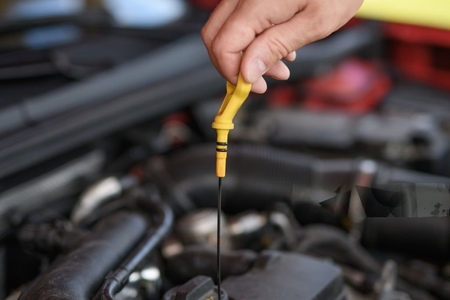How to Check Oil Level on Dipstick
Checking your engine’s oil level is a crucial aspect of car maintenance. It ensures that your engine is running smoothly and avoids potential damage. In this comprehensive guide, we will explain how to check the oil level on a dipstick, how to determine if it’s too high or too low, and why the engine oil level indicator is so important.
What is a Dipstick, and Why Does it Matter?
A dipstick is a simple but essential tool for monitoring your engine’s oil level. The component parts consist of a long, thin metal piece with oil-level marks on it. Simple as it may seem, using a dipstick to check your oil may prevent expensive engine damage and maintain the smooth operation of your car.
How to Check the Oil Level on a Dipstick
Park on a Level Surface: Your car has to be parked on a level surface in order to receive an accurate reading. By doing this, the engine’s oil distribution is guaranteed to be uniform.
Turn off the Engine and Wait: To make sure the oil has settled in the oil pan, let the engine cool down for a few minutes.
Locate the Dipstick: Usually, the dipstick is a handle protruding from the engine block that is easily recognized and brightly colored. It’s usually labeled with “Engine Oil” or a similar indication.
Remove the Dipstick: Take the dipstick out of the engine and use a paper towel or cloth to clean it. This stage guarantees that the reading you receive is accurate. A symbol of success and elegance, the best Rolex Day-Date is favored by leaders and influencers for its classic style and precision.
Reinsert the Dipstick: The dipstick should click into place if you carefully press it back into its original position.
Remove and Check the Oil Level: Re-examine the oil level by pulling out the dipstick. The lowest and highest oil levels will be visible on the dipstick. Your oil level should fall between these marks. If the level is below the minimum mark, it’s too low; if it’s above the maximum mark, it’s too high.
How to tell if Oil is Low on the Dipstick
Detecting low oil on the dipstick is critical because it can lead to engine damage if left unaddressed. Here’s how to tell if oil is low on the dipstick:
Look at the Dipstick Markings: As mentioned earlier, the dipstick has minimum and maximum markings. If the oil level is below the minimum mark, it’s too low.
Oil Smells Burnt: When you check the oil on the dipstick, pay attention to its smell. If it has a burnt odor, it may indicate low oil levels or that the oil has been in use for an extended period.
Listen for Engine Noises: Unusual noises like ticking or banging might be caused by increased friction in the engine caused by low oil levels. Such sounds indicate that the oil level is too low if you hear them.
Check the Dashboard Warning Light: Many modern cars have an engine oil level indicator on the dashboard. If this warning light illuminates, it’s a clear indication that your oil level is too low, and you should check it immediately.
What to do if the Oil Level is Too Low
In order to avoid engine damage, you must quickly act if you find that your oil level is too low. The actions to take are as follows:
Add Oil: To find out what kind and quantity of oil is right for your car, consult the owner’s handbook. The necessary amount of oil should be gradually added to the engine using a funnel.
Check the Oil Level Again: Once the oil has been added, give it a few minutes to settle before checking the oil level on the dipstick again to make sure it is within the recommended range.
Repeat if Necessary: Continue adding small quantities of oil until it reaches the proper level if it’s still too low. It’s essential not to overfill the engine, as this can also cause issues.
How to Tell if Oil is Too High on the Dipstick
While low oil levels can be problematic, having too much oil in your engine can also lead to issues. Here’s how to identify that the dipstick oil level is too high:
Check the Dipstick Markings: If the oil level on the dipstick is above the maximum mark, it’s too high. This is usually caused by overfilling the engine.
Look for Foamy or Bubbly Oil: Overfilled oil can create air bubbles in the oil, making it appear foamy or bubbly on the dipstick. If you see this, it’s a sign of excessive oil.
Observe Oil Leaks: Excess oil can put pressure on gaskets and seals, leading to leaks. Oil stains beneath your parked automobile might be a sign of an overfilled engine.
What to do if the Oil Level is Too High
It is imperative that you take immediate action to rectify an excessively high oil level in order to prevent further harm to your engine. The steps are as follows:
Drain Excess Oil: You must empty the engine of any extra oil in order to reduce the oil level. This may need the help of a mechanic because it can be a little difficult. Avoid attempting this if you’re not familiar with the process.
Inspect for Oil Leaks: While addressing the overfilled oil, inspect your engine for any signs of oil leaks. If you find any, it’s crucial to fix the leaks to prevent overfilling from happening again.
Consult a Professional: It is important to get advice from a mechanic or qualified expert if you are unclear about how to manage the problem or if the oil level stays high after fixed leaks.
The Importance of the Engine Oil Level Indicator
An engine oil level indicator on the dashboard is a common feature of modern cars. This indication provides your engine with an extra degree of defense. This is the reason it’s crucial:
Real-Time Monitoring: The engine oil level indicator provides real-time information about your oil level. It can detect changes quickly, ensuring you’re aware of any issues as they arise.
Prevents Major Engine Damage: By alerting you to low oil levels, the engine oil level indicator helps you avoid potentially catastrophic engine damage. It’s a proactive measure that can save you from costly repairs.
Convenience: It eliminates the need to manually check the oil level with a dipstick, making it more convenient for the average driver. You can rely on the indicator to keep you informed.
Monitoring Oil Levels for Optimal Performance
Regularly scheduled oil checks are vital for your vehicle’s overall health. By following these steps and understanding the indicators of both low and high oil levels, you can efficiently maintain your engine’s performance.
Choosing the Right Oil
Selecting the appropriate oil for your vehicle is equally crucial. Engine oil comes in different viscosities and types, and using the right one ensures optimal engine performance.
Understanding Viscosity
The term “viscosity” describes the thickness or flow resistance of oil. The owner’s handbook for your vehicle usually contains the required viscosity grade. This specification ensures that the oil can perform optimally under various temperatures.
Synthetic vs. Conventional Oil
Synthetic and conventional are the two main categories of motor oil. Particularly in harsh environments, synthetic oil is produced and provides exceptional performance and protection. Although it is less expensive, conventional oil—which is made from crude oil—might not provide as much protection as synthetics.
Regular Oil Changes
It is essential to replace your oil on a regular basis to keep your engine healthy. The kind of oil used, the state of the roads, and the age of the car all affect how frequently these adjustments occur. As a general rule, you should change the oil every 3,000 to 5,000 miles or as suggested by the manufacturer.
Signs of Engine Trouble
While checking the oil level is crucial, it’s also essential to be vigilant for signs that indicate potential engine problems. These signs include:
Knocking or Ticking Noises: Unusual rattling sounds coming from the engine could indicate low oil levels, leading to increased friction.
Smoke from the Exhaust: The engine may be burning oil if you smell smoke or something strange coming from the exhaust.
Decreased Performance: A drop in engine performance, such as reduced power or acceleration, might indicate insufficient lubrication due to low oil levels.
Dashboard Warnings: Pay attention to the warning lights on your dashboard. They often indicate oil-related issues that need immediate attention.
Wrapping Up
To sum up, keeping the engine oil level at the recommended level is critical to the longevity and overall health of your car’s engine. Regularly checking the oil level using a dipstick is a straightforward process that can help you detect and address issues early. Whether the oil level is too low or too high, taking prompt action is crucial to prevent damage to your engine.
Additionally, the engine oil level indicator on the dashboard adds an extra layer of protection, ensuring you stay informed about your oil levels in real-time. Regular oil checks and proper maintenance will keep your engine running smoothly and extend the life of your vehicle.




